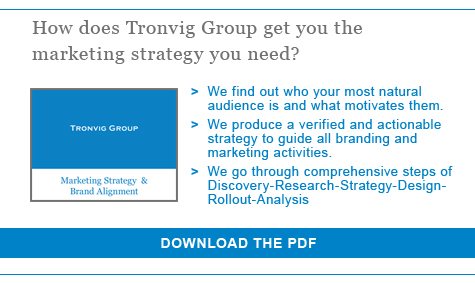A bank brand and sales
I met recently with a friend who is a senior salesperson at a bank. I’ve known him for quite some time, and I’ve known about his bank just as long. We met at his branch, and we talked about a variety of things including his brand, but it was not until I left the meeting, walked down the street and saw another bank’s brand that I realized I had been confusing his bank with another for nearly two years.
I realized I had been confusing his bank with another for nearly two years.
This was not the fault of my friend. He represented his institution very well, but as a sales person you want your brand to have your back. More than that, you want your brand to put wind in your sails. An undifferentiated brand makes the challenge your salespeople face far greater than it should be.
Most brands are inchoate—not fully formed in the consumer’s mind prior to actual first-hand experience with its products or services. This is probably the state of your brand right now, provided you are not Nike, or Volvo, or Chase. I do not mean to say that your brand is not represented by a well-designed and thoughtful logo. Maybe it is. It’s possible that you even have a brand message that your organization is very careful to consistently communicate through all aspects of its interface with the world (websites, stores, advertisements, employees, etc.). Even if you do have these things though, your brand is still very likely to hold little meaning in most of your prospective consumers’ minds.
Your brand is still very likely to hold little meaning in most of your prospective consumers’ minds.
Fixing this inchoate condition is the role of marketing, and also the responsibility of your sales force—but in order for them to be able to do this effectively, they must first have the brand support they need. So an organization must understand the particular brand challenges it faces in its marketplace.
Prior to 12:52PM on Wednesday afternoon last week, the following list summarizes what I knew about my friend’s bank brand:
- My friend works there.
- He and his bank come very highly recommended by many others whom I know.
- This bank is a fast-growing bank that has entered the New York City consumer and business banking markets.
- This bank’s name is made up of two letters, one of which is “T”.
- This bank’s color—its brand color—is green.
Pick a bank brand
Now, imagine I am walking down the street with the above information resting snugly in my head. I casually see only the following bank brands:
Which one of these is my friend’s bank?
I chose the obvious: TD Bank.
Now, when I told my friend that I had always thought he worked for TD Bank and not the bank where he actually works, he was aghast. On the face of things his reaction is easy to understand. How is it possible that I held on to this false brand association despite what he knew was ample evidence all around me to the contrary? Had I not just looked at one of his brochures? Had I not just been inside his bank branch to meet him? He thought I was joking or daft. But what had actually happened was that his brand had failed him, and he had been nearly helpless in the face of this abandonment. A single sales person is not Hercules. And yet this is what his brand demanded of him.
A single sales person is not Hercules. And yet this is what his brand demanded of him.
This situation illustrates a very basic principle. Something his marketing superiors, who are responsible to give brand support to all their sales teams, seemingly failed to consider: human brains naturally seek efficiency.
Brands and mental efficiency
It is important to note that I had no strong emotional or experiential connection with either bank brand. So both were still “protobrands.” I recognized TD Bank because I had seen it a lot. TD is all over New York City. I knew it was green. I knew it had two letters in its name. I knew one of those letters was “T”…
From the outside, for the uninitiated, for those like me with no emotional or practical reason to spend any dedicated time thinking deeply about either of these brands, the simplest and most efficient thing to grab and hold is the least complicated set of assumptions. We do this all the time. Once latched onto, these assumptions continue to be efficient for the brain. It will leave them in place until forced to do otherwise. From a mental efficiency perspective, the connection between my friend and TD bank was a job already done. No need for me to spend mental energy reexamining it.
And so, for almost two years, a single brand story was repeatedly firing off the same set of neurons, strengthening their connections every time I met with my friend, each time he was unwittingly affirming his role at the wrong bank. Please note how tenacious this false brand association was for me. The implications for any brand are profound.
Please note how tenacious this false brand association was for me. The implications for any brand are profound.
I went to my friend’s bank. I had trouble finding it because I was actually looking for a TD branch, but I eventually found it after asking directions in another building. I was warmly greeted by my friend inside the bank. We talked about his work, his bank and its brand for about an hour. I briefly reviewed a new sales brochure that had just come in. I took photos of his storefront! And still the neurons that had muscled up around “friend=TD” were not ready to surrender their position. It’s as if they were conspiring to obscure from my consciousness any and all inconvenient facts.
I know this sounds incredible. How did I think I was looking at a TD Bank branch when the bank’s actual name can be read in big gold letters right there? Any rational mind would say, “It’s obvious!” But as I have pointed out before, your rational mind is not really the one in charge, and your rational mind is certainly not assigned the task of maintaining efficiency in mental operations. These operations are unconscious, as are 98% of all our mental activities. Add to this the critical fact that my emotional engagement with these brands was still low. This leaves Mr. Efficiency busy working behind the scenes with no good reason to spend any extra effort making adjustments. So on it went until I was presented with incontrovertible evidence. I essentially had to be shown the two brands side-by-side before my rational mind finally took a stand, and in that moment sent an urgent memo to Mr. Efficiency, “You need to reassess!”

Moral of the story
The moral of this story is that while it may be true in the minds of those inside my friend’s bank that the distinctions between their brand and that of TD Bank are myriad and blatantly obvious, the reality is that in my mind they were not, and this usurpation of one brand by another stubbornly remained in place for me right up until some rather particular circumstances conspired to forcibly correct the situation.
I’m not saying that everyone is going to confuse TD with my friend’s bank, but this does show the brand challenge his bank faces as it pushes down along the I-95 corridor where TD is already well established and filling a vacant brand space in people’s minds. Unless it goes where TD is not, his bank and its salespeople will always be fighting in the face of a strong and well-established competitor whose visual and associative brand space is really too close for comfort.
What does this mean for you and your brand?
How much work are you leaving entirely up to your sales people?
Are you trying to dislodge a competitor with offers and messages that can be easily confused with theirs?
Are you presenting yourself visually in ways that make you hard to differentiate?
Do you know what mental or emotional space your competition occupies in your prospect’s minds?
Are you trying to share that space or find another to occupy on your own?
Have you clearly identified the emotional drivers that service your brand?
Are you using your marketing outlays to clearly differentiate from your strongest competitors, or are you unwittingly using it to feed those competitor’s customer acquisition programs?
With respect to my friend’s bank, a properly formed brand did not exist for me until 12:52PM Wednesday, October 29th, even though I knew a great deal about this bank through my friend. Think about what that means. Everything I had learned—all of the positive attributes that had been accruing to him—were actually being applied by me not to his bank, but to TD. Despite my friend’s best efforts, I was giving it all to the competition!
Don’t let this happen to you.
If you are seeking to dislodge an existing player on their own terms, without some strong emotional drivers (yes, even a bank can and should have emotional drivers) that point firmly toward you, the path ahead for your brand is likely to involve an almost Herculean effort. And if you have not meaningfully differentiated your brand from the competition you are, in effect, dumping the responsibility to carry out that effort on your sales people.
This is all too common.
It is also useful to think about your marketing outlays, all that money you spend on signage, advertising, collateral, websites—all of it. Are you using it to clearly differentiate from your strongest competitors, or are you unwittingly using it to feed those competitor’s customer acquisition programs?
I really hate when that happens.
To learn about the Tronvig Group process, click below to sign up for our mailing list and get access to our library of downloadable guides, including the following:












Ask for help.
We are kind, thorough and ready when you are. You just need to ask.